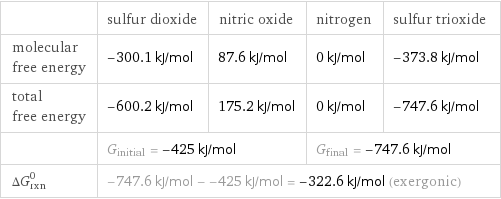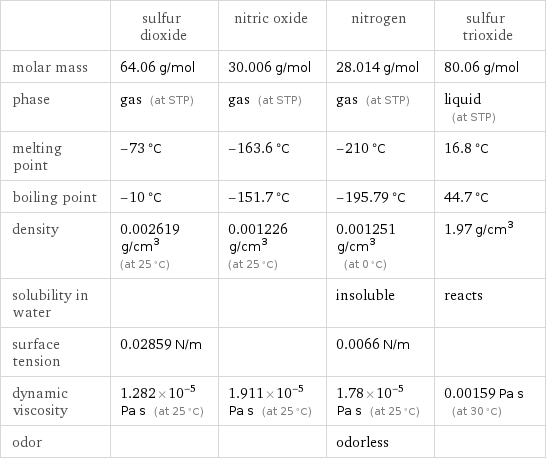Input interpretation

SO_2 sulfur dioxide + NO nitric oxide ⟶ N_2 nitrogen + SO_3 sulfur trioxide
Balanced equation

Balance the chemical equation algebraically: SO_2 + NO ⟶ N_2 + SO_3 Add stoichiometric coefficients, c_i, to the reactants and products: c_1 SO_2 + c_2 NO ⟶ c_3 N_2 + c_4 SO_3 Set the number of atoms in the reactants equal to the number of atoms in the products for O, S and N: O: | 2 c_1 + c_2 = 3 c_4 S: | c_1 = c_4 N: | c_2 = 2 c_3 Since the coefficients are relative quantities and underdetermined, choose a coefficient to set arbitrarily. To keep the coefficients small, the arbitrary value is ordinarily one. For instance, set c_3 = 1 and solve the system of equations for the remaining coefficients: c_1 = 2 c_2 = 2 c_3 = 1 c_4 = 2 Substitute the coefficients into the chemical reaction to obtain the balanced equation: Answer: | | 2 SO_2 + 2 NO ⟶ N_2 + 2 SO_3
Structures

+ ⟶ +
Names

sulfur dioxide + nitric oxide ⟶ nitrogen + sulfur trioxide
Reaction thermodynamics
Gibbs free energy

| sulfur dioxide | nitric oxide | nitrogen | sulfur trioxide molecular free energy | -300.1 kJ/mol | 87.6 kJ/mol | 0 kJ/mol | -373.8 kJ/mol total free energy | -600.2 kJ/mol | 175.2 kJ/mol | 0 kJ/mol | -747.6 kJ/mol | G_initial = -425 kJ/mol | | G_final = -747.6 kJ/mol | ΔG_rxn^0 | -747.6 kJ/mol - -425 kJ/mol = -322.6 kJ/mol (exergonic) | | |
Equilibrium constant
![Construct the equilibrium constant, K, expression for: SO_2 + NO ⟶ N_2 + SO_3 Plan: • Balance the chemical equation. • Determine the stoichiometric numbers. • Assemble the activity expression for each chemical species. • Use the activity expressions to build the equilibrium constant expression. Write the balanced chemical equation: 2 SO_2 + 2 NO ⟶ N_2 + 2 SO_3 Assign stoichiometric numbers, ν_i, using the stoichiometric coefficients, c_i, from the balanced chemical equation in the following manner: ν_i = -c_i for reactants and ν_i = c_i for products: chemical species | c_i | ν_i SO_2 | 2 | -2 NO | 2 | -2 N_2 | 1 | 1 SO_3 | 2 | 2 Assemble the activity expressions accounting for the state of matter and ν_i: chemical species | c_i | ν_i | activity expression SO_2 | 2 | -2 | ([SO2])^(-2) NO | 2 | -2 | ([NO])^(-2) N_2 | 1 | 1 | [N2] SO_3 | 2 | 2 | ([SO3])^2 The equilibrium constant symbol in the concentration basis is: K_c Mulitply the activity expressions to arrive at the K_c expression: Answer: | | K_c = ([SO2])^(-2) ([NO])^(-2) [N2] ([SO3])^2 = ([N2] ([SO3])^2)/(([SO2])^2 ([NO])^2)](../image_source/05edd48166676111d2b4fa24b0ba059f.png)
Construct the equilibrium constant, K, expression for: SO_2 + NO ⟶ N_2 + SO_3 Plan: • Balance the chemical equation. • Determine the stoichiometric numbers. • Assemble the activity expression for each chemical species. • Use the activity expressions to build the equilibrium constant expression. Write the balanced chemical equation: 2 SO_2 + 2 NO ⟶ N_2 + 2 SO_3 Assign stoichiometric numbers, ν_i, using the stoichiometric coefficients, c_i, from the balanced chemical equation in the following manner: ν_i = -c_i for reactants and ν_i = c_i for products: chemical species | c_i | ν_i SO_2 | 2 | -2 NO | 2 | -2 N_2 | 1 | 1 SO_3 | 2 | 2 Assemble the activity expressions accounting for the state of matter and ν_i: chemical species | c_i | ν_i | activity expression SO_2 | 2 | -2 | ([SO2])^(-2) NO | 2 | -2 | ([NO])^(-2) N_2 | 1 | 1 | [N2] SO_3 | 2 | 2 | ([SO3])^2 The equilibrium constant symbol in the concentration basis is: K_c Mulitply the activity expressions to arrive at the K_c expression: Answer: | | K_c = ([SO2])^(-2) ([NO])^(-2) [N2] ([SO3])^2 = ([N2] ([SO3])^2)/(([SO2])^2 ([NO])^2)
Rate of reaction
![Construct the rate of reaction expression for: SO_2 + NO ⟶ N_2 + SO_3 Plan: • Balance the chemical equation. • Determine the stoichiometric numbers. • Assemble the rate term for each chemical species. • Write the rate of reaction expression. Write the balanced chemical equation: 2 SO_2 + 2 NO ⟶ N_2 + 2 SO_3 Assign stoichiometric numbers, ν_i, using the stoichiometric coefficients, c_i, from the balanced chemical equation in the following manner: ν_i = -c_i for reactants and ν_i = c_i for products: chemical species | c_i | ν_i SO_2 | 2 | -2 NO | 2 | -2 N_2 | 1 | 1 SO_3 | 2 | 2 The rate term for each chemical species, B_i, is 1/ν_i(Δ[B_i])/(Δt) where [B_i] is the amount concentration and t is time: chemical species | c_i | ν_i | rate term SO_2 | 2 | -2 | -1/2 (Δ[SO2])/(Δt) NO | 2 | -2 | -1/2 (Δ[NO])/(Δt) N_2 | 1 | 1 | (Δ[N2])/(Δt) SO_3 | 2 | 2 | 1/2 (Δ[SO3])/(Δt) (for infinitesimal rate of change, replace Δ with d) Set the rate terms equal to each other to arrive at the rate expression: Answer: | | rate = -1/2 (Δ[SO2])/(Δt) = -1/2 (Δ[NO])/(Δt) = (Δ[N2])/(Δt) = 1/2 (Δ[SO3])/(Δt) (assuming constant volume and no accumulation of intermediates or side products)](../image_source/fd436843a7c452b4776e717ff471ecd0.png)
Construct the rate of reaction expression for: SO_2 + NO ⟶ N_2 + SO_3 Plan: • Balance the chemical equation. • Determine the stoichiometric numbers. • Assemble the rate term for each chemical species. • Write the rate of reaction expression. Write the balanced chemical equation: 2 SO_2 + 2 NO ⟶ N_2 + 2 SO_3 Assign stoichiometric numbers, ν_i, using the stoichiometric coefficients, c_i, from the balanced chemical equation in the following manner: ν_i = -c_i for reactants and ν_i = c_i for products: chemical species | c_i | ν_i SO_2 | 2 | -2 NO | 2 | -2 N_2 | 1 | 1 SO_3 | 2 | 2 The rate term for each chemical species, B_i, is 1/ν_i(Δ[B_i])/(Δt) where [B_i] is the amount concentration and t is time: chemical species | c_i | ν_i | rate term SO_2 | 2 | -2 | -1/2 (Δ[SO2])/(Δt) NO | 2 | -2 | -1/2 (Δ[NO])/(Δt) N_2 | 1 | 1 | (Δ[N2])/(Δt) SO_3 | 2 | 2 | 1/2 (Δ[SO3])/(Δt) (for infinitesimal rate of change, replace Δ with d) Set the rate terms equal to each other to arrive at the rate expression: Answer: | | rate = -1/2 (Δ[SO2])/(Δt) = -1/2 (Δ[NO])/(Δt) = (Δ[N2])/(Δt) = 1/2 (Δ[SO3])/(Δt) (assuming constant volume and no accumulation of intermediates or side products)
Chemical names and formulas

| sulfur dioxide | nitric oxide | nitrogen | sulfur trioxide formula | SO_2 | NO | N_2 | SO_3 Hill formula | O_2S | NO | N_2 | O_3S name | sulfur dioxide | nitric oxide | nitrogen | sulfur trioxide IUPAC name | sulfur dioxide | nitric oxide | molecular nitrogen | sulfur trioxide
Substance properties

| sulfur dioxide | nitric oxide | nitrogen | sulfur trioxide molar mass | 64.06 g/mol | 30.006 g/mol | 28.014 g/mol | 80.06 g/mol phase | gas (at STP) | gas (at STP) | gas (at STP) | liquid (at STP) melting point | -73 °C | -163.6 °C | -210 °C | 16.8 °C boiling point | -10 °C | -151.7 °C | -195.79 °C | 44.7 °C density | 0.002619 g/cm^3 (at 25 °C) | 0.001226 g/cm^3 (at 25 °C) | 0.001251 g/cm^3 (at 0 °C) | 1.97 g/cm^3 solubility in water | | | insoluble | reacts surface tension | 0.02859 N/m | | 0.0066 N/m | dynamic viscosity | 1.282×10^-5 Pa s (at 25 °C) | 1.911×10^-5 Pa s (at 25 °C) | 1.78×10^-5 Pa s (at 25 °C) | 0.00159 Pa s (at 30 °C) odor | | | odorless |
Units
